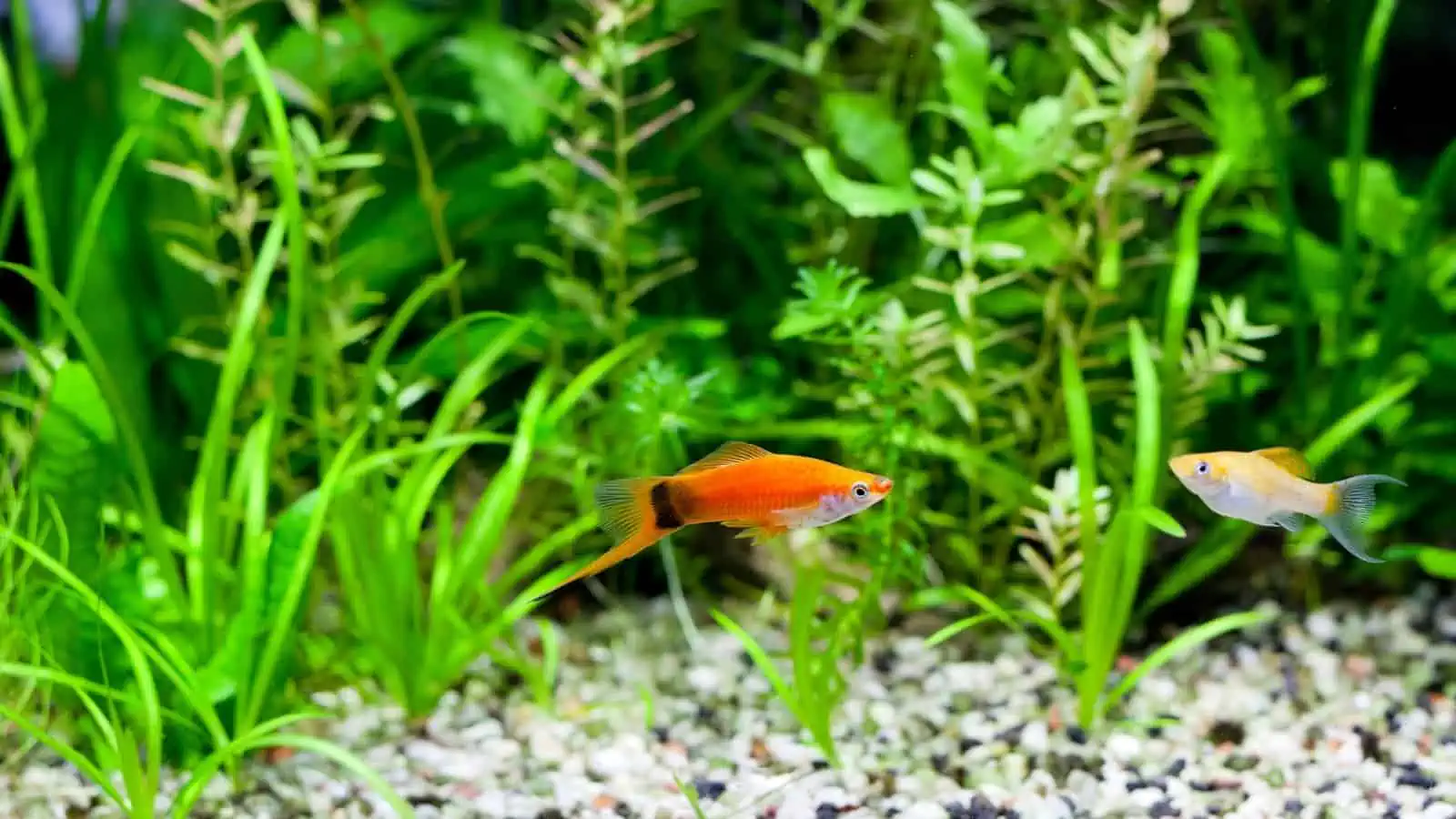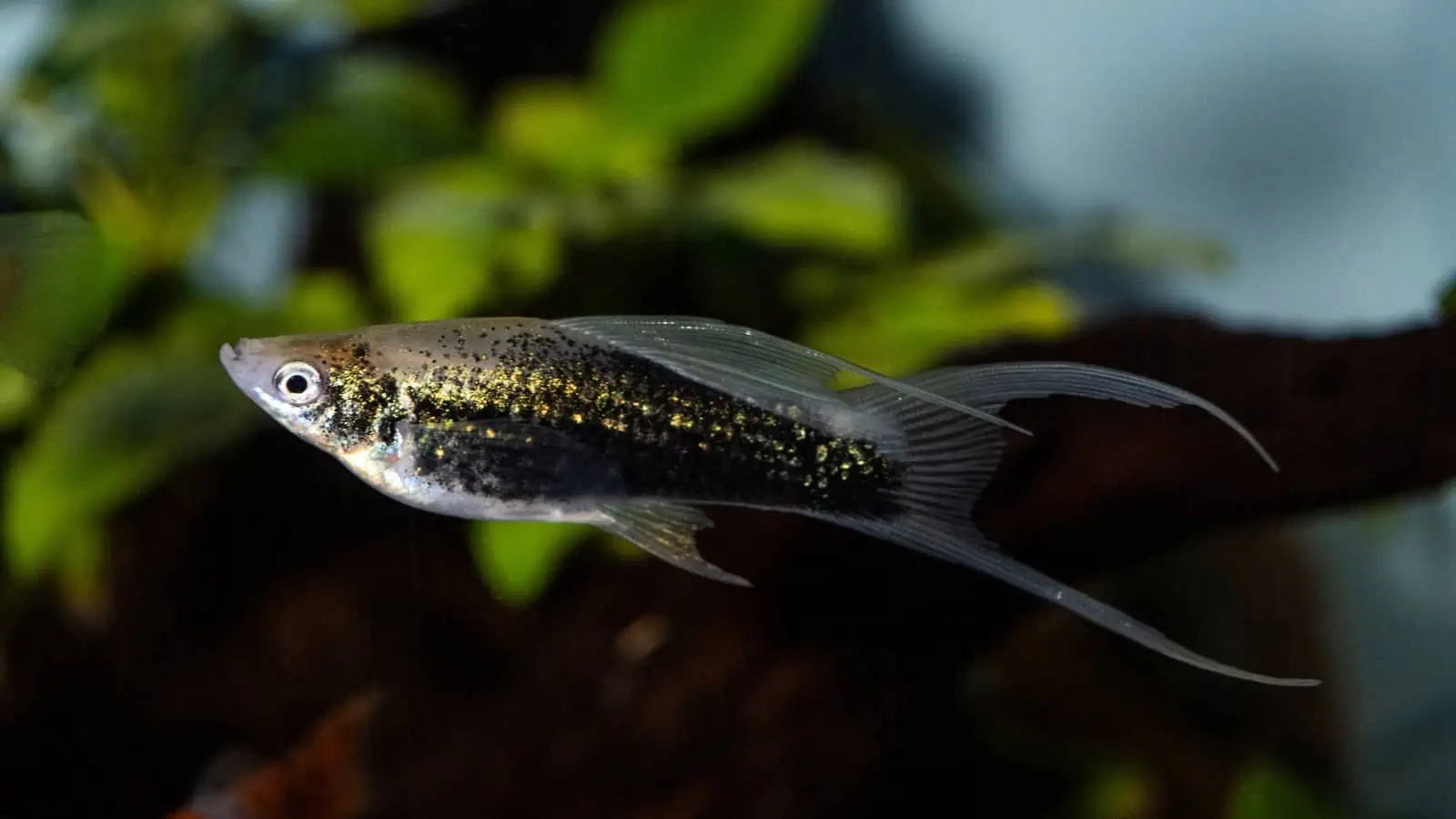[ad_1]
A jewel in the freshwater community tanks, the swordtail brings an energetic aura into their aquarium. Their quick movements and ease of care make these active fish a popular fish for the community aquarium.
Novice aquarists, however, should be aware that mixed groups of swordtails can reproduce very quickly, and can also interbreed with platies. This means you need a plan in place regarding how to take care of their young.
Keep reading for everything you need to know about swordtail care and keeping your swordtails happy and healthy!
Swordtail natural habitat
The swordtail originally came from Honduras and Central Mexico, living in highly planted areas with fast water movement.
| Swordtail Fish Info | |
|---|---|
| Minimum tank size | 30 gal (114 L) long |
| Temperament | Peaceful |
| Diet | Omnivore |
| Temperature | 72-82 °F/22-27 °C |
| pH | 7-8 |
Swordtail Appearance
Male swordtails carry the distinct trait that the species is known for, the long and pointed tail known as its sword. Female swordtail fish have the same body shape and size but lack the extended sword on their tail
The body of the swordtail is similar to the molly fish but with a uniform curve on both sides of its back. The swordtail is often available in red and orange colors but has been bred into a large variety of colors. Some breeders even raise purple swordtails!
Swordtails vary in their maximum size and grow to between 3 and 6 inches long depending on the variety. Many new owners are misled as pet stores will sell very young swords that are hardly an inch long, leading to overstocking, stress, and eventually death as the fish become too big for their tank.
Swordtail Color Variations
Selective breeding has produced swordtails of many different shapes and colors.
Some of the most popular include the green swordtail, pygmy swordtail, yellow swordtail, Chiapas swordtail, delicate swordtail, Panuco swordtail, comma swordtail, sheepshead swordtail, and marbled swordtail.
Swordtail Fish Care Guide
Water Parameters
Swordtails prefer water of anywhere between 72 and 82 degrees Fahrenheit and a pH between 7 and 8. These conditions can often be met without any water adjustments, making swordtails also one of the easiest choices for starter fish. This is not to say swordtails have no requirements.
Tank Size
They do need a tank of at least 30 gallons or a 20-gallon breeder tank. The focus here is the tank length, as swordtails need long stretches of water to swim through. Confining them into a smaller tank can result in high stress and territorial behavior that is not common for this peaceful fish.
Tank Lid
Due to the fast-swimming nature of the swordtails, jumping is a frequent problem for inexperienced owners. Keep all aquarium tops under a tight cover to prevent carpet-surfing fish!
Aquarium Plants
While not necessary, swordtails love tall, dense plants in the aquarium. This replicates their natural environment and will greatly reduce stress levels. Both real and plastic plants may be used, with live plants giving your tank the added benefit of increasing the water quality and oxidizing the water.
Some of the best plants to choose are Scarlet Temple and Java Ferns.
Swordtail water quality
Swordtails are one of the larger common freshwater fish and can surprise owners with the increase in bioload they produce. A strong hang-on-back or canister filter is often recommended as it takes minimal tank space while providing high amounts of filtration.
Remember that while the filter does help remove waste from the tank, the addition of 4 or more swords at once will cause ammonia spikes. Provide your tank with adequate water changes to ensure your aquarium does not crash and stays balanced while the tank adjusts to its new members.
Swordtail Health and Disease
The swordtail is generally a hardy tropical fish that does well in many home aquariums.
The main threat to these long-tailed fish is fin rot, which is one of the more noticeable illnesses. This can be taken care of by keeping the water quality very high at all times and avoiding tank mates that can nip fins.
Ich, velvet, and flukes are all common parasitic diseases that can lie dormant in an aquarium for years until a weakened fish or very poor water quality offers them a chance to strike.
Similarly, bacterial and fungal infections like columnaris and water moulds only tend to affect fish that are already in a vulnerable state.
In summary, the best defense against most health problems is excellent tank maintenance and ensuring high water quality.
Swordtail Tankmates

Swordtails have a huge advantage when it comes to picking tank mates.
The peaceful nature they exhibit to other species allows the owner to introduce almost any other fish that can survive under the same water conditions without incident. These include neon tetra and red eye tetras, corydoras catfish, and mollies (as demonstrated in the video above).
Exceptions that should be noted are fin nippers and predators. While the second is true of most peaceful fish, fin nipping is a much more common problem among swordtail owners in particular. Their long flowing tails make them easy targets for a passing fish. Combined with their lack of aggression, swordtails will often allow the fin nipping until they become stressed to the point of illness.
Fin nippers to avoid are tiger barbs, multiple tetra breeds such as white spot, black widow, blue and serpae tetras, and Betta fish. Bettas will often confuse the sword’s long tail as another betta and quickly start fighting.
Swordtail Gender and Aggression
When choosing your swordtails, be sure you do not only select fish with the actual swordtail. These are the male swordtails. While most community fish can be kept in larger schools, swordtails have an unusually high desire to express dominance over other male swords.
To keep more than one male sword, owners must often house at least 4 females per 1 male sword. These females will take most if not all of the male’s attention, removing their desire to fight the other males.
For owners with tanks under 50 gallons, I can only recommend you house one male sword. Most aquarists follow the rule of one inch of fish per gallon of water.

With a max size of 6 inches and the need for 4 supplemental females, tanks would find themselves overstocked with 10 fish each of 6 inches in size. While tanks can have this many fish, owners will find increased aggression due to the lack of territories as well as the demand for more frequent water changes.
Feeding Swordtails
Due to their hardy nature, swordtails will accept nearly any food you provide them. Feeding a large group of swordtails will often result in a real feeding frenzy, as can be seen in the video above.
But while flake foods and fish pellets are good basic fish food for swordtails, they’ll really thrive when given frequent supplements of live and frozen foods such as bloodworms, tubifex worms, daphnia, brine shrimp, mosquito larvae, mysis shrimp, and vegetable supplements like spirulina and nori flakes.
As usual, feed your fish twice a day, with no more than they can eat in 2 minutes. Overfeeding is one of the most common causes of water quality and health problems in aquarium fish. Even if your fish seem hungry, be careful not to feed too much!
Breeding Swordtails
While only a few owners actively try to breed their fish, swordtails will almost always give birth in the new tank. As most stores will carry male and female swordtails all in one tank, it’s highly likely that the female fish you buy will already have mated and be pregnant.
Simply put, if you own female swordtails you will almost certainly have new fry.
Swordtails are live-bearing fish with quick signs of pregnancy. Once the female has become pregnant, a dark spot will develop near the back fin and her belly will begin to swell. Care will need to be taken to ensure the fry survives. Many owners will place the female into a breeding net and remove her upon the birth of the fry.
This method will work and can save owners the hassle of setting up a breeding tank. The downside to this method is the stress caused by the breeding net on the pregnant fish. This can lead to early fish birth, or worse, the loss of the parent. To avoid these risks a second tank will need to be set up.
Raising Swordtail Fry
With the new fry born, the parent must be removed and the fry are to be kept separate from any other adult fish. If the fry were born into the main tank, large areas of dense brush can provide refuge to the fry.
As the swordtail is a live-bearing fish, the fry are born with large enough mouths to accept most commercially available foods. Live foods such as baby brine shrimp and microworms make excellent foods as well.
As the fry age, more and more males will develop their swords. Separate the obvious males, the ones with swordtails, from the rest of the fry. As more and more males are removed, the less dominant males will begin to grow their swords. After a week of no new swords, it is safe to assume there are no more males left in the group.
Once the swords hit 1.5 inches in length they are ready to be added to their new home. Remember to always add your new fish at night, giving them time to settle in before they are noticed by the other fish. Keep an eye on these new additions and watch as they join your now-expanded community.
Swordtails will also crossbreed with platies to produce hybrid offspring. Since the resulting offspring are often weak and difficult to sell, keeping the two species together is questionable.
Final Thoughts
Swordtails are robust, hardy fish for tropical community tanks, and are often recommended for beginners.
Novice fish keepers should be aware, however, of the swordtail’s tendency to reproduce and multiply. If you don’t want a tank overrun by baby swordtails, it is important to plan what you’ll do with the large numbers of swordtail fry that will inevitably follow!
If you have any more questions about keeping swordtails or want to share your own experiences with these colorful livebearers, don’t hesitate to leave a comment below. Happy fishkeeping!
[ad_2]
Source link
